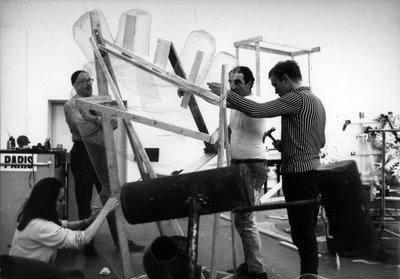Cubitt Gallery, a non-for-profit space in Angel, North London, recently hosted an exhibition by artist Andy Holden. Consisting of a library / installation, Andy’s works, and a group show ‘Language of Flowers and the Stars’, it explored the unfinished concept of Thingly Time as espoused by the artists close friend and philosophical collaborator Dan Cox, who tragically died in a cycling incident in Dalston last year.
The exhibition thus charts the developments of concepts and theory through an amalgamation of literary and aesthetic sources in conversation or dialogue between two people. The group show is thus an exemplification of the concept, and a visual way in for the viewer. The exhibition was accompanied by a series of reading groups, in which key texts were discussed in non-hierarchical format, and often accompanied by performance or music.

– Do you think artists have more freedom in the curator role?
There are possibly some advantages, perhaps the relationships to the objects is slightly different, asking to borrow without a hierarchy, as a fellow maker, the reverence is different, not less, but different, or what you’re asking of the works or artists, or perhaps just being less aware of the protocol and conventions. But it depends what curator, with good curators I doubt the approach is so different. With the “Language of the Flowers and the Stars” it was an exhibition within an exhibition and almost all of the artists I asked to contribute had come out of a dialogue built up over time, who on a gut level I knew had concerns within their practice that were directly linked to the idea of Thingly Time. Although I also had a extra freedom as it was not really my concept I was curating, Thingly Time was the unfinished concept, announced by Dan Cox to me on the day of his death, and this notion is something at once very ambiguous and very precise. It’s something we’d talked a lot about in the lead up to my show at Kettle’s Yard, before Dan deterritorialsed, so it’s an idea that I feel I understand, not easy to articulate in words, but, hopefully, possible to manifest through a selection of works and objects.
– Is an exhibition such as the Dan Cox Library of Thingly Time an artwork in itself?
I’m not sure it matters. It helped me to think of it as an exhibition within the Library, a space that I am self-appointed custodian of. I thought of it more like a panorama, or a diorama, in the sense of “through that which is seen”, a free standing picture viewing device linked to landscape. It provided a vista which surrounded the library, but was also a space of research, providing concrete possibilities of objects that could, when placed together, shed light upon the nature of Thingly Time. The whole nature of the “in itself” is perhaps thrown into question by Thingly Time, which is closer to an object-orientated view, or attempts other ways to re-think the “in itself” though a re-examination of duration. The works and object, I would hope, resist being assimilated into some total work, still functioning as Things, however it was a presentation also concerned with making these pieces available as research, gateways to other bodies of knowledge, and together providing a space that allowed the visiter to perhaps grasp something of Thingly Time.
– Your work deals with layers of sedimented material, and this show seems to be an archeological excavation in itself. Did you consciously develop the display to mirror the form of your work?
Hard to say, but that analogy, between sediment, accretion, and the formation of a thought process is one that is relevant to Thingly Time. How objects, and thoughts form, across time, becoming visible, objects that reveal their duration, and the strata lines of sediment in relation to the pages of the books is at the heart of the exhibition, and this could be thought of as an excavation.
– How important is literature to your practice as an artist?
In terms of my new role as custodian to the Dan Cox Library for the Unfinished concept of Thingly Time, quite pivotal. The library also hosts reading groups which took place each week. Hosted by myself and Francesco Pedraglio it had contributions from Francesco and Paul Becker, David Raymond Conroy and Gil Leung. The third week I presented together with Ed Atkins and we talked about Roberto Bolano. Ed recommended I read theSavage Detectives, which had been part of Dan’s Library. For Bolano literature has the power to shed blood, to really change things, an act of upmost importance. More and more this is something that I would subscribe to. For Dan, books, both theory and literature were everything; as custodian of the Library books are the key material, and the sentiment found Bolano that bubbled in Dan, is one that I will hope the work facilitates.
– The sad death of Dan Cox cut short the theory of Thingly Time, do you hope for a visitor to complete, or multiply, it through accessing the library?
It’s not something I think can be completed. Much of the exhibition is also about the urgency of dialogue, and friendship. The book shelves exist on islands of carpet that have printed on them copied passages from Flaubert’sBouvard et Pecuchet, a book for me that above and beyond it’s satirical questioning of knowledge becomes about advancing through dialogue, traversing the horizontal plane of text, and those moments of dialogue from which spring glimmers and possibilities of something more concrete, something perhaps knowable after all, made possible through friendship. But Thingly Time I think, hopefully as the curated element shows, is something already shared by other artists, something in the air, and I hope the combination of the works and the books in the Library will allow viewers to really immerse themselves and contribute to the endless extension of the concept of Thingly Time.


























